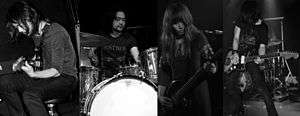Mono (Japanese band)
| Mono | |
|---|---|
|
Mono (left to right): Yoda, Takada, Tamaki, Taka. | |
| Background information | |
| Origin | Tokyo, Japan |
| Genres | Post-rock,[1][2][3][4][5] instrumental rock |
| Years active | 1999–present |
| Labels | Temporary Residence Limited, Conspiracy, Human Highway, Tzadik |
| Website |
www |
| Members |
Takaakira "Taka" Goto Hideki "Yoda" Suematsu Tamaki Kunishi Yasunori Takada |
Mono (stylised as MONO) is a Japanese post-rock band, formed in 1999 in Tokyo. The band consists of Takaakira "Taka" Goto (electric guitar, glockenspiel), Hideki "Yoda" Suematsu (electric guitar, glockenspiel), Tamaki Kunishi (bass guitar, electric guitar, piano, glockenspiel), and Yasunori Takada (drum kit, glockenspiel, synthesizer).
Mono has released nine studio albums. The band spent their early years, from 1999 to 2003, touring Asia, Europe, and America continuously, and released two studio albums, Under the Pipal Tree (2001) and One Step More and You Die (2002) on the Tzadik and Music Mine Inc. record labels, respectively. From 2004 to 2007, Mono signed to Temporary Residence Limited, released two more studio albums, Walking Cloud and Deep Red Sky, Flag Fluttered and the Sun Shined (2004) and You Are There (2006), and toured worldwide in their support. In 2008, the band took a break, returning one year later with a new studio album, Hymn to the Immortal Wind (2009), also on Temporary Residence Limited. During the tour that followed they recorded a live album, Holy Ground: NYC Live With The Wordless Music Orchestra which was released in 2010. In October 2016 the band released their ninth studio album, titled Requiem for Hell.
The band's style of music is influenced by the genres of experimental rock and shoegazing, as well as by both the classical and contemporary classical periods of classical music, and also by noise and minimalism. Mono's sound is characterised by the lead and rhythm guitars of Goto and Yoda respectively, both of whom make extensive use of reverb, distortion and delay effects. The band's live performances are noted for their intensity, both in the playing and in the dynamics.
History
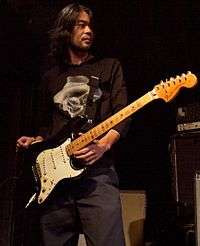
Formation and early years: 1999–2000
In January 1999, Japanese Tokyo-native electric guitarist Takaakira "Taka" Goto began composing music and spent the remainder of the year searching for other musicians with which to form an instrumental rock band; eventually recruiting long-time friend and fellow electric guitarist Hideki "Yoda" Suematsu on rhythm guitar.[6] By December 1999, Tamaki Kunishi and Yasunori Takada had joined Mono on bass guitar and drums, respectively. The band played their first show in late January 2000, at Club 251 in Setagaya, Tokyo.[7] In May 2000, the band entered Rinky Dink Studio in Tokyo and recorded their first extended play with engineers Tetsuya Morioka and Toshiro Kai, which was later self-released in September 2000; a Japan-only release titled Hey, You on their own independent record label, Forty-4. The band spent the bulk of the year composing more music and performing live at various live houses around Tokyo, in the neighbourhoods of Setagaya, Shimokitazawa, and Shibuya. Mono also travelled to the United States to play a one-off show in November at the Mercury Lounge in New York City; a show which was later described by Paul Wheeler of rockofjapan.com as having a "big beautiful sound that [...] naturally [expanded] through each song."[8]
Under the Pipal Tree: 2001
Following the release of the Hey, You extended play, Mono spent the next year playing live shows throughout their native Japan, as well as playing several shows in New York City and Sweden. The band also made an appearance at the 2001 South by Southwest music festival in Austin, Texas. Between performing in Japan, Mono recorded their first studio album, Under the Pipal Tree at Studio Take-1 and Forty-4 in Tokyo. The majority of the tracks were recorded live (a trend which the band would adopt for all subsequent studio albums) in one day, the recording session of which was funded by experimental American musician John Zorn, with the band handling production duties. The album featured two previously released tracks (from the Hey, You extended play), as well as six original compositions. The album was released worldwide through New York City record label Tzadik, owned and operated by John Zorn.
One Step More and You Die: 2002–2003
After the release of Under the Pipal Tree, the band spent the next year touring Japan and the United States, also visiting Germany and Taiwan in support of the album, as well as composing new material inspired by the tour. In June 2002, between shows in Japan, the band recorded their second studio album, One Step More and You Die at Little Bach and Sound City studios in Tokyo, with Mono again handling production duties. The album was released in Japan in October of that year on Japanese record label Music Mine Inc. The band spent most of 2003 touring in support of the album, returning to Japan, the United States, Sweden, and visiting Canada, Switzerland, Belgium, Hungary, the Netherlands, France, and the United Kingdom for the first time.
Walking Cloud and Deep Red Sky, Flag Fluttered and the Sun Shined: 2004
Mono's next release was a collaboration with Japanese musician Aki Onda; whom the band met while touring New York in 2002. The band, Onda, and several notable members of the New York experimental music scene (including DJ Olive, Jackie-O Motherfucker, and Loren Connors) remixed One Step More and You Die. The album, titled New York Soundtracks, was released in February 2004 on Human Highway, Mono's own record label, and a successor to Forty-4.
In January 2004, the band began a long partnership with Chicagoan recording engineer Steve Albini, recording their third studio album at Electrical Audio Engineering in Chicago, Illinois. The album, titled Walking Cloud and Deep Red Sky, Flag Fluttered and the Sun Shined was released in April 2004 on Human Highway in Japan, and on Rykodisk in Europe and Temporary Residence Limited in the United States later in the year. After the album's release, the band embarked upon a year-long tour of America, Asia, and Europe.
You Are There: 2005–2007

The band also spent 2005 touring Asia, America, and Europe composing music, and eventually returning to Electrical Audio Engineering in February and September to record their fourth studio album with Steve Albini. The album, titled You Are There was released in Japan in March 2006 on Human Highway, and on Temporary Residence Limited in the United States and Europe. Mono also collaborated with Japanese musician World's End Girlfriend in 2005, releasing a collaboration studio album in December of that year, on Human Highway, and with American band Pelican, releasing a split album with the band through Temporary Residence Limited in October 2005.
Mono spent 2006 and 2007 touring Asia, America and Europe in support of You Are There. In October 2006, the band returned to Electrical Audio Engineering and recorded a four-track extended play, which was released in April 2007 as part of Temporary Residence Limited's Travels in Constants series, titled The Phoenix Tree. In November 2006, the band released a two-track extended play titled Memorie dal Futuro through Vinyl Films, and also contributed a track to a Temporary Residence Limited compilation album, Thankful. In September 2007, the band released their first compilation album, compiling material from all previous extended plays, split albums, and compilations, titled Gone: A Collection of EPs 2000–2007, as well as the music documentary DVD, The Sky Remains the Same as Ever, documenting the worldwide tours of 2006 and 2007 and the recording of The Phoenix Tree extended play.
Hymn to the Immortal Wind: 2008–2011
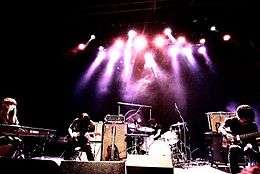
In 2008, the band took a year-long break from touring, spending the time composing new music and playing a handful of shows throughout the year, including an appearance at All Tomorrow's Parties in Somerset, England, curated by Explosions in the Sky in May. Mono returned to Electrical Audio Engineering in June and November 2008 to record their fifth studio album, Hymn to the Immortal Wind, which was later released in March 2009, and followed by a year-long tour of America and Eurasia. The band played a ten-year anniversary show at the Society for Ethical Culture Hall in New York, United States on 8 May 2009, accompanied by the 24-piece Wordless Music Orchestra. The performance was recorded and later released as both a live album and a DVD, named Holy Ground: NYC Live With The Wordless Music Orchestra, through Temporary Residence Limited in Europe and America, and Human Highway in Asia. The band then took another year-long break and went into "hibernation mode", returning to Japan to work on songs for a new album.
For My Parents: 2012–2014
Mono spent early 2012 recording a new album at Waterfront Studios in Hudson, New York, with recording engineers Henry Hirsch, accompanied by the Wordless Music Orchestra.[9] The album was mixed by Fred Weaver at his studio, Apocalypse the Apocalypse, in Clearfield, Pennsylvania. For My Parents was MONO's first record in eight years not to be recorded by Steve Albini at Electrical Audio Studios in Chicago. For My Parents, was released on 4 September 2012, through Temporary Residence Limited.[10] The band's press release for For My Parents states "We hope that this album serves as a gift from child to parent. While everything else continues to change, this love remains a constant throughout time."[10]
The Last Dawn/Rays of Darkness: 2014–2016
Mono released a double album on 24 October 2014, two contrasting records: The Last Dawn, being a more traditional Mono record; and Rays of Darkness, some of their heaviest material, even more notable for the first use of vocals on The Hand That Holds The Truth.
Requiem for Hell: 2016–present
Mono announced the forthcoming release of Requiem For Hell on 19 July 2016, their ninth studio album. Another double album, it reintroduces strings to their sound.[11]
Musical style
Although Mono's musical style has developed throughout their career, it has primarily been characterised by dynamic, guitar-based instrumental soundscapes, the majority of which are composed by lead guitarist Takaakira Goto, in an attempt to channel and express the emotions of joy and sorrow.[12] The band's style of music originally featured elements of minimalism and noise, and later developed to integrate more complex, orchestral arrangements and instrumentation.[13] Mono's music is sometimes categorised as "post-rock", to which Goto has stated:
Music is communicating the incommunicable; that means a term like post-rock doesn't mean much to us, as the music needs to transcend genre to be meaningful.
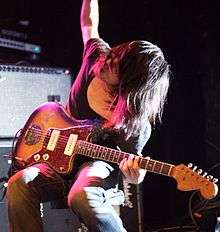
Mono is primarily a live band, and has toured worldwide several times. Their live show tends to feature intense and emotional playing by the band members, as well as using extreme dynamics (in crescendos as well as diminuendos) in their attempt to create an "unforgettable" live performance.[15] When recording their music, the band has always played live in the studio and, from 2004's Walking Cloud and Deep Red Sky, Flag Fluttered and the Sun Shined to 2009's Hymn to the Immortal Wind, worked with Chicagoan recording engineer Steve Albini, whom they feel accurately captured a live band's "raw emotion to [magnetic] tape."[16]
Influences
Mono has drawn influence from various musical and non-musical sources throughout their career. When the band first formed, their main influences were American experimental rock band Sonic Youth and Anglo-Irish shoegaze band My Bloody Valentine when making Under the Pipal Tree and One Step More and You Die.[6] As the band broadened their musical tastes, starting with the album, Walking Cloud and Deep Red Sky, Flag Fluttered and the Sun Shined, they began to be influenced by music from sources such as German classical composer Ludwig van Beethoven, Italian film score composer Ennio Morricone, and later Polish minimalist composer Henryk Górecki, among others.[12] Lead guitarist Takaakira Goto has also acknowledged Danish film director Lars von Trier (in particular the 1996 film, Breaking the Waves) as a major influence since the band's formation, in terms of expressing the different depths and heights of emotion.[12]
Instrumentation
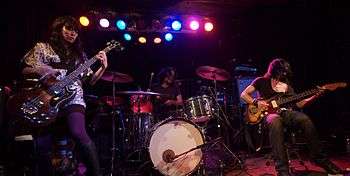
In terms of instrumentation, Mono is a four-piece instrumental rock band. Goto, the group's frontman, is the lead guitarist and uses a 1966 Fender Jazzmaster through Boss, Danelectro, SiB, and Morley effects pedals, into a Fender Twin, a Marshall JCM 2000 head, and a Marshall cabinet for amplification.[17] Yoda, the rhythm guitarist, uses a 1974 Fender Stratocaster through Boss, Tech 21 and Pro Co effects pedals, into a Fender Twin for amplification.[17] Kunishi, the group's bass guitarist, pianist and occasional guitarist uses a 1966 Gibson EB-3 through Boss, TC Electronic, and Tech 21 effects pedals, into an Ampeg B2-R head and a Sunn bass cabinet, as well as a Fender Rhodes, and a Fender Jazzmaster.[17] Takada, the drummer, uses a four-piece 1970s Ludwig drum kit, with Zildjian, Sabian, and Paiste cymbals, as well as a Korg microKORG synthesizer.[17]
As the band's career has progressed, they have incorporated string sections on record, beginning with Under the Pipal Tree, which featured use of cello, continuing with One Step More and You Die and Walking Cloud and Deep Red Sky, Flag Fluttered and the Sun Shined which both featured string quartets, and You Are There, which featured a string quintet. On Hymn to the Immortal Wind, the band made use of a 28-piece chamber orchestra.
Members
- Takaakira "Taka" Goto – lead guitar, glockenspiel
- Hideki "Yoda" Suematsu – rhythm guitar, glockenspiel
- Tamaki Kunishi – bass guitar, guitar, piano, glockenspiel
- Yasunori Takada – drum kit, synthesizer, glockenspiel
Discography
Studio albums
- Under the Pipal Tree (2001)
- One Step More and You Die (2002)
- Walking Cloud and Deep Red Sky, Flag Fluttered and the Sun Shined (2004)
- You Are There (2006)
- Hymn to the Immortal Wind (2009)
- For My Parents (2012)
- The Last Dawn (2014)
- Rays of Darkness (2014)
- Requiem for Hell (2016)
Compilation albums
Split albums & EPs
- Mono/Pelican (Mono - Pelican) (2005)
- Palmless Prayer/Mass Murder Refrain (Mono - World's End Girlfriend) (2006)
- Transcendental (Mono - The Ocean) (2015)
Extended plays
- Hey, You (2000)
- Memorie dal Futuro (2006)
- The Phoenix Tree (2007)
Remix albums
- New York Soundtracks (2004)
Live albums
- Holy Ground: NYC Live With The Wordless Music Orchestra (2010)
- The Last Dawn/Rays of Darkness: Tour 2014 - 2015 (2015)
DVDs
- The Sky Remains The Same As Ever (2007)
- Holy Ground: NYC Live With The Wordless Music Orchestra (2010)
References
- ↑ "Mono". Sputnikmusic. Retrieved December 19, 2012.
- ↑ Page, Paul. "Mono". entertainment.ie. Retrieved December 19, 2012.
- ↑ "Mono". Insound. Retrieved December 19, 2012.
- ↑ Becker, Daniel Levin (October 2004). "Mono". CMJ (127). ISSN 1074-6978.
- ↑ "Mono - Hymn to the Immortal Wind". Spin. 25 (6): 91. June 2009. ISSN 0886-3032.
- 1 2 "MONO interview © terrascope online". Terrascope.co.uk. 2006-04-10. Retrieved 2010-05-27.
- ↑ "Internet Archive Wayback Machine". Web.archive.org. 2007-11-08. Archived from the original on November 8, 2007. Retrieved 2012-04-17.
- ↑ "& Others-live (M-N)". Rockofjapan.com. Retrieved 2010-05-27.
- ↑ MONO. "Tweet". Twitter. Retrieved 20 June 2012.
- 1 2 Battan, Carrie. "Mono Announce New Album". Pitchfork. Retrieved 20 June 2012.
- ↑ "MONO to release 9th album "Requiem For Hell" on October 14th!". Pelagic-records.com. Retrieved 2016-10-14.
- 1 2 3 "JudasKiss - Mono – interview". Monkeyhouse-recordings.co.uk. Retrieved 2010-05-27.
- ↑ "PRIMER: Mono Shares the Back Stories Behind Their Massive Catalogue, Including That One 10" They Did For Cameron Crowe | self-titled magazine :: s/t daily". Self-titledmag.com. 2009-05-09. Retrieved 2010-05-27.
- ↑ St John, Colin (23 April 2009). "No bubblegum inside". Time Out. Retrieved 8 December 2012.
- ↑ "Experience Mono". Star-ecentral.com. 2008-07-02. Retrieved 2010-05-27.
- ↑ "Mono find fan in Steve Albini | The Japan Times Online". Search.japantimes.co.jp. 2007-08-31. Retrieved 2010-05-27.
- 1 2 3 4 Mecham, Joseph. "Mono Gear Review". guitarjunkie.net. Retrieved 20 March 2012.
External links
| Wikimedia Commons has media related to Mono (band). |
- Official website
- Mono at Temporary Residence Limited
- Mono at Human Highway
- Mono at Live Music Archive
